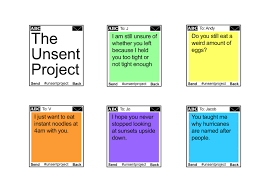The Unsent Project is a unique digital space that shares heartfelt, unsent messages to first loves. This platform offers a collection of poignant, personal stories that capture the essence of unspoken feelings and untold experiences. If you’re interested in exploring this emotive archive, here’s a comprehensive guide on how to read stories on The Unsent Project and make the most of your experience.
Understanding The Unsent Project
As described on its website, the Unsent Project serves as a repository of unsent texts addressed to first loves. The platform allows individuals to share their narratives—those they never had the chance to communicate in person. These unsent messages range from confessions and regrets to declarations of love and reflections on past relationships.
The project aims to create a communal space where people can express and process their emotions by sharing untold stories. Each entry is a window into someone’s emotional world, offering insights into love, loss, and the human experience.
Navigating the Website
Homepage Exploration
You’ll land on the homepage when you first visit The Unsent Project. Here, you’ll find an overview of the site’s purpose and featured stories. The homepage often highlights recent or popular entries, providing a glimpse into the kind of messages shared by contributors.
Story Categories
The Unsent Project may categorize stories based on themes or emotions. Look for categories such as “Love,” “Regret,” “Longing,” or “Closure.” These categories can help you find stories that resonate with specific feelings or experiences you’re interested in exploring.
Search Functionality
If you’re looking for something specific, use the search function. Enter keywords related to the emotions or themes you’re interested in, such as “heartbreak,” “nostalgia,” or “unspoken.” The search tool will filter through the vast collection, presenting stories that match your criteria.
Reading a Story
Selecting a Story
Once you find a story that interests you, click on the title or preview to read it in full. Each entry typically includes the unsent message and any additional context the contributor provides.
Story Format
Stories on The Unsent Project are often presented in a simple, text-based format. This minimalist approach allows the content to shine without distractions. You’ll read the unsent message as it was submitted, preserving its raw and authentic nature.
Interactive Features
Some stories may include interactive features such as comments or reactions. Engage with these features to share your thoughts or connect with other readers. Your comments can contribute to the community’s ongoing conversation about love and personal experiences.
Engaging with the Community
Commenting on Stories
After reading a story, consider leaving a comment. Share your reflections, relate to the emotions expressed, or support the author. Comments create a dialogue between readers and contributors, fostering a sense of connection and empathy.
Sharing Your Own Story
If you feel inspired, you can contribute your unsent message. The Unsent Project often provides a submission form where you can write and share your narrative. Your story could provide comfort or insight to others going through similar experiences.
Social Media and Community Interaction
Follow The Unsent Project on social media to stay updated on new stories and community events. Engaging with the project’s social media accounts allows you to connect with a broader audience and participate in discussions about the themes and emotions explored on the website.
Respecting Privacy and Sensitivity
Respecting Contributors’ Privacy
While The Unsent Project encourages sharing personal stories, it’s essential to respect contributors’ privacy. Each story reflects someone’s personal experience and emotions. Approach each story with empathy and understanding.
Handling Sensitive Content
Some stories may touch on sensitive or emotional topics. If you encounter distressing or triggering content, take care of your emotional well-being. If needed, it’s okay to step away from the site and return when ready.
Exploring Additional Features
Curated Collections
The Unsent Project may offer curated collections or featured themes that share related stories. These collections can provide a deeper exploration of specific topics or emotions, offering a more focused reading experience.
Contributor Profiles
Sometimes, you might find contributor profiles or additional information about the authors. This can offer insight into their motivations for sharing their stories and provide context for their messages.
Events and Special Features
The Unsent Project may host special events like live readings, interactive discussions, or themed writing challenges. Watch for announcements and updates to participate in these unique opportunities.
Making the Most of Your Experience
Reflect on the Stories
Take the time to reflect on the stories you read. Consider how they relate to your own experiences and emotions. Reflecting on these messages can provide personal insights and a deeper understanding of your feelings.
Engage Thoughtfully
When interacting with the community, do so thoughtfully and respectfully. Your contributions—whether comments, feedback, or stories—can profoundly impact others. Approach each interaction with kindness and consideration.
Share the Project
If you find value in The Unsent Project, consider sharing it with others. Whether through social media or word-of-mouth, spreading the word can help the project reach more people and expand its community.
Conclusion
The Unsent Project is more than just a collection of unsent messages; it’s a heartfelt exploration of unspoken emotions and untold stories. By understanding how to navigate the website, engage with the community, and reflect on the stories, you can fully appreciate the depth and beauty of the messages shared on this unique platform. Whether you’re a reader seeking solace or inspiration, or a contributor looking to share your narrative, The Unsent Project offers a meaningful space to connect and reflect on the complexities of love and human experience.
